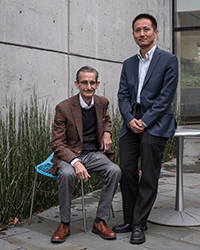Six Gene Loci Associated with Gestational Duration and Spontaneous Preterm Birth
|
Top Breakthrough Discovery | Published September 2017 in The New England Journal of Medicine |

Louis Muglia, MD, PhD and Ge Zhang, MD, PhD
A breakthrough discovery from a globe-spanning team of scientists provides the first strong genomic links to preterm birth and provides fresh guidance in the hunt for ways to prevent the world’s leading cause of death among children under age 5.
The study was coordinated by Louis Muglia, MD, PhD, Co-Director of the Perinatal Institute at Cincinnati Children’s and principal investigator of the March of Dimes Prematurity Research Center—Ohio Collaborative. First author was Ge Zhang, MD, PhD, of the Division of Human Genetics.
They worked with researchers from Sweden, Norway, Denmark, Finland, Yale University, the University of Iowa, and the genetic testing company 23andMe. Funding came primarily from the March of Dimes, the National Institutes of Health, the Research Council of Norway, the Swedish Research Council, and the Bill & Melinda Gates Foundation.
Large-scale approach to complex problem
In addition to the risk of death, preterm birth often leads to lifelong problems including chronic lung disease, vision and hearing impairment, cerebral palsy, and neurodevelopmental disabilities.
“We have known for a long time that preterm birth is a combination of genetic and environmental factors. Previous research has suggested that about 30 to 40 percent of the risk for preterm birth is linked to genetic factors. This new study is the first to provide robust information as to what some of those genetic factors actually are,” Muglia says.
Identifying the biological causes of preterm birth has been a high priority for the March of Dimes, says Stacey Stewart, the organization’s president. “This is a very exciting discovery that can be expected to lead to the development of new treatments to prevent pregnant women from going into labor too soon and to give more babies a healthy start in life.”
Finding the genomic needles of preterm birth risk involved analyzing a haystack of data that was at least five times larger than any previous study of the topic. One dataset included more than 44,000 women who provided saliva samples to 23andMe. Another crucial reference dataset involved more than 8,000 Nordic women from the Mother Child Cohort of Norway (MoBa); The Finnish Birth Cohort (FIN); and the Danish National Birth Cohort (DNBC).




